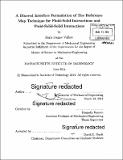A blurred interface formulation of The Reference Map Technique for Fluid-Solid Interactions and Fluid-Solid-Solid Interactions
Author(s)
Valkov, Boris Ivanov
DownloadFull printable version (26.22Mb)
Other Contributors
Massachusetts Institute of Technology. Department of Mechanical Engineering.
Advisor
Kenneth Kamrin.
Terms of use
Metadata
Show full item recordAbstract
In this work we present a blurred interface method for Fluid-Solid Interactions (FSI) and multiple solids immersed in a fluid or FSSI (Fluid-Solid-Solid Interactions) based on the reference map technique as presented by Kamrin and Rycroft. I will follow the chain of thought which lead from the initial sharp interface technique to the newer blurred interface one. We will present its capabilities of doing fully-coupled simulations of a compressible Navier-Stokes fluid and highly non-linear solid undergoing large deformations all performed on a single Eulerian grid with no Lagrangian particles whatsoever. The Reference Map Technique (RMT) provides an Eulerian simulation framework allowing to compute fully coupled fluid/soft-solid interactions. However, due to the extrapolations inherent to the Ghost Fluid Method (GFM) for fluid/fluid interactions, on which the RMT is based, numerical artifacts get created in the resulting pressure and velocity fields whenever the levelset defining the interface crosses a gridpoint from the fixed cartesian grid utilized in this method. We will therefore follow the creation and propagation of these artifacts as well as analyze how the blurred technique solves or avoids these problems.
Description
Thesis: S.M., Massachusetts Institute of Technology, Department of Mechanical Engineering, 2014. Cataloged from PDF version of thesis. Includes bibliographical references (pages 143-144).
Date issued
2014Department
Massachusetts Institute of Technology. Department of Mechanical EngineeringPublisher
Massachusetts Institute of Technology
Keywords
Mechanical Engineering.